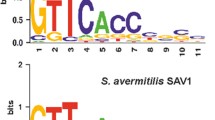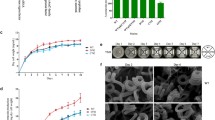Abstract
Under limiting growth conditions,Aspergillus nidulans produces a carcinogenic secondary metabolite related to aflatoxin and called sterigmatocystin (ST). The genes for ST biosynthesis are co-ordinately regulated and are all found within an approximately 60-kilobase segment of DNA. One of the genes within this region is predicted to encode a CX2CX6CX6CX2CX6CX2 zinc binuclear cluster DNA-binding protein that is related to theAspergillus flavus andAspergillus parasiticus aflatoxin regulatory geneaflR. Deletion of theA. nidulans aflR homolog resulted in an inability to induce expression of genes within the ST gene cluster and a loss of ST production. BecauseA. nidulans aflR mRNA accumulates specifically under conditions that favor ST production we expect that activation of ST biosynthetic genes is determined byA. nidulans aflR. In support of this hypothesis, we demonstrated that induced expression of theA. flavus aflR gene inA. nidulans, under conditions that normally suppress ST gene expression, resulted in activation of genes in the ST biosynthetic pathway. This result demonstrates that AflR function is conserved betweenAspergillus spp. and thataflR expression is sufficient to activate genes in the ST pathway.
Similar content being viewed by others
References
Adams TH, Boylan MT, Timberlake WE (1988)brlA is necessary and sufficient to direct conidiophore development inAspergillus nidulans. Cell 54:353–362
Adamson RH (1989) Induction of hepatocellular carcinoma in non-human primates by chemical carcinogens. Cancer Detect Prev 14:215–219
Aharonowitz Y, Cohen G, Martin JF (1992) Penicillin and cephalosporin biosynthetic genes: structure, organization, regulation, and evolution. Annu Rev Microbiol 46:461–495
Aucamp PJ, Holzapfel CW (1970) Polyhydroxyanthraquinones fromAspergillus versicolor, Aspergillus nidulans andBipolaris spp. Their significance in relation to biogenetic theories on Aflatoxin B1. J S Afr Chem Inst 23:40–56
Barnes SE, Dola TP, Bennett JW, Bhatnagar D (1994) Synthesis of sterigmatocystin on a chemically defined medium by species ofAspergillus andChaetomium. Mycopathologia 125:173–178
Bennett JW, and Papa KE (1988) The aflatoxigenicAspergillus species. Adv Plant Pathol 6:263–280
Bennett JW, Bhatnagar D, Chang PK (1994) The molecular genetics of aflatoxin biosynthesis. In: Powell KA (ed) The genusAspergillus. Plenum Press, New York, pp 51–58
Bhatnagar D, Ehrlich KC, Cleveland TE (1992) Oxidation-reduction reactions in biosynthesis of secondary metabolites. In: Bhatnagar D, Lillehoj EB, Arora DK (eds) Handbook of Applied Mycology. Marcel Dekker, New York, pp 255–286
Bressac B, Kew M, Wands J, Ozturk M (1991) Selective G to T mutations of p53 gene in hepatocellular carcinoma from southern Africa. Nature 350:429–431
Brown DW, Yu J-H, Kelkar HS, Fernandes M, Nesbitt TC, Keller NP, Adams TH, Leonard TJ (1996) Twenty-five co-regulated transcripts define the sterigmatocystin gene cluster inAspergillus nidulans. Proc Natl Acad Sci USA 93:1418–1422
Burger G, Strauss J, Scazzocchio C, Lang BF (1991)nirA, the pathway-specific regulatory gene of nitrate assimilation inAspergillus nidulans, encodes a putative GAL4-type zinc finger protein and contains four introns in highly conserved regions. Mol Cell Biol 11:5746–5755
Chang P-K, Cary JW, Bhatnagar D, Cleveland TE, Bennett JW, Linz JE, Woloshuk CP, Payne GA (1993) Cloning of theAspergillus parasiticus apa-2 gene associated with the regulation of aflatoxin biosynthesis. Appl Environ Microbiol 59:3273–3279
Chang P-K, Ehrlich KC, Yu J, Bhatnagar D, cleveland TE (1995) Increased expression ofAspergillus parasiticus aflR, encoding a sequence-specific DNA-binding protein, relieves nitrate inhibition of aflatoxin biosynthesis. Appl Environ Microbiol 61:2372–2377
Church GM, Gilbert W (1984) Genomic sequencing. Proc Natl Acad Sci USA 81:1991–1995
Cole RJ, Cox RH (1981) Handbook of toxic fungal metabolites. Academic Press, New York, pp 67–93
Cove DJ (1979) Genetic studies of nitrate assimilation inAspergillus nidulans. Biol Rev 54:291–327
Diener UL, Cole RJ, Sanders TH, Payne GA, Lee LS, Klich MA (1987) Epidemiology of aflatoxin formation byAspergillus flavus. Annu Rev Phytopathol 25:249–270
Dutton MF (1988) Enzymes and aflatoxin biosynthesis. Microbiol Rev 52:274–295
Fujii K, Kurata H, Odashima S, Hatsuda Y (1976) Tumor induction by a single subcutaneous injection of sterigmatocystin in newborn mice. Cancer Res 36:1615–1618
Giniger E, Varnum SM, Ptashne M (1985) Specific DNA-binding of GAL4, a positive regulatory protein of yeast. Cell 40:767–774
Herbert RB (1989) Polyketides. In: The biosynthesis of secondary metabolites. Chapman and Hall, London, pp 31–62
Jelinek CF, Pohland AE, Wood GE (1989) Worldwide occurrence of mycotoxins in foods and feeds—an update. J Assoc Off Anal Chem 72:223–230
Johnstone IL, McCabe PC, Greaves P, Gurr SJ, Cole GE, Brow MAD, Unkles SE, Clutterbuck AJ, Kinghorn JR, Innis MA (1990) Isolation and characterization of thecrnA-niiA-niaD gene cluster for nitrate assimilation inAspergillus nidulans. Gene 90:181–192
Käfer E (1977) Meiotic and mitotic recombination inAspergillus and its chromosomal aberrations. Adv Genet 19:33–131
Keller NP, Cleveland TE, Bhatnagar D (1992) A molecular approach towards understanding aflatoxin production. In: Bhatnagar D, Lillehoj EB, Arora DK (eds). Handbook of Applied Mycology. Marcel Dekker, Inc., New York, pp 287–310
Keller NP, Dischinger HCJ, Bhatnagar D, Cleveland TE, Ullah AH (1993) Purification of a 40-kilodalton methyltransferase active in the aflatoxin biosynthetic pathway. Appl Environ Microbiol 59:479–484
Keller NP, Kantz NJ, Adams TA (1994)Aspergillus nidulans verA is required for production of the mycotoxin sterigmatocystin. Appl Environ Microbiol 60:1444–1450
Keller NP, Brown DW, Butchko RAE, Fernandes M, Kelkar H, Nesbitt C, Segner S, Bhatnagar D, Cleveland TE, Adams TH (1995) A conserved polyketide mycotoxin gene cluster inAspergillus nidulans. In: Richard JL (ed) Molecular approaches to food safety issues involving toxic microorganisms. Alaken Inc., Port Collins, pp 263–277
Klich MA, Pitt JI (1988) A laboratory guide to the commonAspergillus species and their teleomorphs. CSIRO Division of Food Processing, North Ryde, Australia
McConnell IR, Garner RC (1994) DNA adducts of aflatoxins, sterigmatocystin and other mycotoxins. IARC Scientific Publication No. 125, pp 49–55
Payne GA, Nystrom GJ, Bhatnagar D, Cleveland TE, Woloshuk CP (1993) Cloning of theafl-2 gene involved in aflatoxin biosynthesis fromAspergillus flavus. Appl Environ Microbiol 59:156–162
Proctor RH, Hohn TM, McCormick SP, Desjardins AE (1995)tri6 encodes an unusual zinc finger protein involved in regulation of trichothecene biosynthesis inFusarium sporotrichioides. Appl Environ Microbiol 61:1923–1930
Samson RA (1992) Current taxonomic schemes of the genusAspergillus and its teleomorphs. In: Bennett JW, Klich MA (eds)Aspergillus: biology and industrial applications. Butterworth-Heinemann, Boston, pp 355–390
Scott PM, van Walbeek W, Kennedy B, Anyeti D (1972) Mycotoxins and toxigenic fungi in grains and other agriculture. J Agric Food Chem 20:1103–1109
Skory CD, Chang P, Cary J, ELJ (1992) Isolation and characterization of a gene fromAspergillus parasiticus associated with the conversion of versicolorin A to sterigmatocystin in aflatoxin biosynthesis. Appl Environ Microbiol 58:3527–3537
Stack M, Rodricks JV (1971) Method for analysis and chemical confirmation of sterigmatocystin. J Assoc Off Anal Chem 54:86–90
Trail F, Mahanti N, Rarick M, Mehigh R, Liang S-H, Zhou R, Linz JE (1995) Physical and transcriptional map of an aflatoxin gene cluster inAspergillus parasiticus and functional disruption of a gene involved early in the aflatoxin pathway. Appl Environ Microbiol 61:2665–2673
Wieser J, Adams TH (1995)flbD encodes a Myb-like DNA-binding protein that regulates initiation ofAspergillus nidulans conidiophore development. Genes Dev 9:491–502
Woloshuk CP, Fount KR, Brewer JF, Bhatnagar D, Cleveland TE, and Payne GA (1994) Molecular characterization ofaflR, a regulatory locus for aflatoxin biosynthesis. Appl Environ Microbiol 60:2408–2414
Yabe K, Ando Y, Hashimoto J, Hamasaki T (1989) Two distinctO-methyltransferases in aflatoxin biosynthesis. Appl Environ Microbiol 55:2172–2177
Yager LN, Kurtz MB, Champe SP (1982) Temperature-shift analysis of conidial development inAspergillus nidulans. Dev Biol 93:92–103
Yelton MM, Hamer JE, Timberlake WE (1984) Transformation ofAspergillus nidulans by using atrpC plasmid. Proc Natl Acad Sci USA 81:1470–1474
Yu J, Cary JW, Bhatnagar D, Cleveland TE, Keller NP, Chu FS (1993) Cloning and characterization of a cDNA fromAspergillus parasiticus encoding anO-methyltransferase involved in aflatoxin biosynthesis. Appl Environ Microbiol 59:3564–3571
Yu J, Chang P-K, Cary JW, Wright M, Bhatnagar D, Cleveland TE, Payne GA, Linz JE (1995) Comparative mapping of aflatoxin pathway gene clusters inAspergillus parasiticus andAspergillus flavus. Appl Environ Microbiol 61:2365–2371
Author information
Authors and Affiliations
Additional information
Communicated by B.G. Turgeon
Rights and permissions
About this article
Cite this article
Yu, JH., Butchko, R.A.E., Fernandes, M. et al. Conservation of structure and function of the aflatoxin regulatory geneaflR fromAspergillus nidulans andA. flavus . Curr Genet 29, 549–555 (1996). https://doi.org/10.1007/BF02426959
Received:
Issue Date:
DOI: https://doi.org/10.1007/BF02426959




